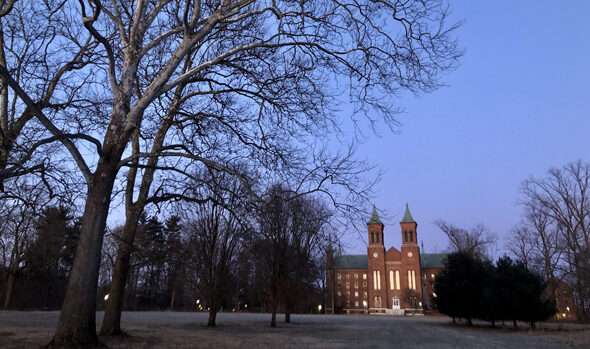
The decisions to eliminate nine staff and faculty positions and to "restructure" an additional eight positions with title changes and salary reductions follow a several fundraising campaigns over the last year. (Photo by Kathleen Galarza)
Layoffs, restructuring at Antioch College
- Published: March 16, 2023
Antioch College President Jane Fernandes publicly announced in a Feb. 21 statement that the college had eliminated nine staff and faculty positions and has plans to “restructure” an additional eight positions with title changes and salary reductions.
The statement went onto report that department budgets for programming — including for the Coretta Scott King Center and Herndon Gallery — were also eliminated and that hours paid for on-campus student jobs were reduced.
These decisions follow a $2.5 million fundraising campaign last fall and the Martin Luther King Jr. Day announcement of a new $5 million fundraising campaign which was kicked off by Fernandes and her husband with the donation of $25,000 of their own personal funds.
Antioch’s new goal is to raise $5 million by June.
“This is the hardest part of our turnaround plan,” Fernandes said in the press release, which noted that the decisions were “painful.” “Antioch is a small, unique community and we deeply value the hard work, gifts, and friendship of every member. We will be tested, and I hope we will practice grace with each other.”
Fernandes also said that the college has looked at the organizational structures for staff and faculty numbers at other liberal arts colleges in the region that are similar to Antioch.
“We’re comparing faculty to student ratio and staff to student ratio,” she said.
According to data Director of Communications Matt Shetler provided to the News, Antioch has 127 students enrolled at Antioch as of last fall, including 34 entering students. There are currently 21 faculty and 56 staff members employed at the college.
According to Fernandes, other colleges are operating with smaller, leaner faculty and staff numbers.
“We’ll have to make some adjustments to be in line with our own plan,” she said.
In a Feb. 1 interview with the News, Fernandes said Antioch leadership was working on a new business model for the college.
“The reason why we need a new business model is because the revenue that we bring in now is not sufficient to run the college. And we are committed to the student population, curriculum, our cooperative education, co-ops, scholarships,” she said. “But we have to acknowledge that if we don’t change the business model, we won’t have enough money to operate.”
The press release mentioned additional actions items Antioch would take to regain “solid financial footing.” As written in a one-page document provided by Antioch, the items include:
• “Continued strategic hiring of essential staff positions to reflect core values and operations.”
• “Continued strategic hiring of faculty positions to reflect our faculty hiring plan, emerging curriculum, and accreditation needs.”
• “Increased spending protocols to manage cash flow and focus on necessary expenses.”
• “Increased grant-seeking to fund our core mission and activities.”
• “Initial efforts to fully activate campus learning hubs and community-based workshops to contribute to both mission and revenue generation.”
Antioch’s emerging business model includes “right-sizing and strategic plan goals” of:
• “Deepened mission and clear value”
• “Diverse students plus expanded community”
• “Balanced budget plus diversified revenue”
According to Fernandes, the new business model is still being developed, but will in part “focus on revenue generation” through what she calls “learning hubs.” These hubs include the Foundry Theater, Coretta Scott King Center, Antioch farm and Wellness Center.
The document also included an immediate action item for the college to form exploratory groups and pilot models to consider the feasibility of new revenue models.
Strategies for implementing Antioch’s emerging business model will begin in fiscal year 2024, which starts July 1 and will see the college, in addition to the implementation of learning hubs, prioritize the following areas:
• Curriculum (tuition/fees/Pell)
• Co-op
• Scholarships
• Student jobs
• Housing and kitchens
• Real estate/facilities
• Fundraising
The News was not able to obtain budget figures from Antioch that showed what, if any, deficits or fiscal challenges are hampering the college, nor was the News able to obtain any budget information about how much the restructuring plan will cost the school.
2 Responses to “Layoffs, restructuring at Antioch College”
The Yellow Springs News encourages respectful discussion of this article.
You must login to post a comment.
Don't have a login? Register for a free YSNews.com account.















The academic core has been slightly improved but still lacks the resources and faculty necessary to be considered a full-fledged liberal arts college. The college’s philosophy of education is generalized social advocacy without any backbone. The reason the college can’t obtain enrollments is the underdeveloped curriculum and the complete lack of ability on the part of the current trustees to bring about major development. The campus is partially restored, but Antioch has a long way to go to achieve an adequate (1,000) student population. Currently, it is an ersatz institute with a model that is long in the tooth and an insular faculty. The only way out is to add trustees who can do more than talk to stage the final recovery, including hiring a really talented admissions team. There are a few good professors, but you would need to nearly double the faculty to get to stage one.
When you have a college that offers an education that students don’t value and employers have no use for – this is the result.